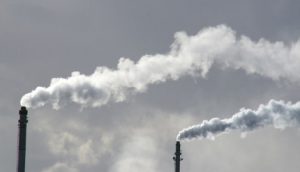Every year, the Carbon Disclosure Project (CDP) asks companies in Asia (excluding Japan) to release information about their carbon emissions and climate-change actions. Its latest report is out today. Chaoni Huang of research group Trucost and CDP’s Antigone Theodorou explain what they found.
More than half of the companies in Asia that responded to the latest request for climate-change information from the Carbon Disclosure Project (CDP) expect to benefit from government policies to tackle climate change. That was a key finding in the “CDP Asia ex-Japan Climate Change Report 2012”, which was co-authored and analysed by natural capital research company Trucost and covers countries in Asia excluding Japan.
CDP surveyed 400 companies in Asia that it deemed most relevant to investors and comparable in terms of size and importance to the region’s economy. The report, published today, shows that 32% of the 400 responded – an increase of almost 20% from 27% in 2011.
Twenty-three companies based in China responded, up from 10 in 2011. South Korea and Taiwan-based companies were most likely to answer the questionnaire or provide some information.
The responses provide valuable insight into how companies navigate the region’s emerging climate-change regulations to reduce greenhouse-gas emissions.
Approximately 30% of 117 responding companies identifed near-term regulatory opportunities. Planned cap-and-trade programmes and other carbon-related policies are expected to boost top-line growth within the next five years. For instance, South Korea’s Act on Allocation and Trading of Greenhouse Gas Emissions Allowances will establish Asia’s first nationwide emissions trading scheme. Last month, South Korea doubled a target to cut greenhouse-gas emissions from local industrial and power sectors, to enhance competitiveness before the cap-and-trade scheme starts.
Many of the respondents said that they hope to generate carbon credits for sale to companies covered by carbon-trading schemes. Emissions-trading systems in South Korea and Australia, both expected to be up and running in 2015, will allow companies to surrender a limited number of international carbon credits for emissions-reduction projects in countries with voluntary commitments under the Kyoto Protocol. Regional trials of carbon trading in China are also expected to demand carbon credits, to help meet a 17% carbon emissions per unit of GDP reduction target by 2015, published in the country’s 12th Five-Year Plan.
Companies in many Asian countries will profit from selling carbon credits regulated under the UN Kyoto Protocol Clean Development Mechanism. India and China currently generate the majority of projects that qualify for carbon credits under the mechanism globally.
Fears of brand damage
Some 28% of responding companies think that they can already capitalise on low-carbon opportunities, with most business opportunities linked to revenue growth from low-carbon products and services. Responses show that companies consider the financial benefits of low-carbon branding to be equivalent to the risks borne by firms that remain unresponsive to an environmentally friendly consumer shift. Brand damage or greening consumer choices were among the most common risk drivers identified for companies that are not set for the shift to a low-carbon economy.
Companies in finance and IT in particular demostrate awareness of the potential to make profits from regulatory change to cut carbon. The Financial and IT sectors were also most likely to carry out emissions-reduction activities in the region surveyed.
Energy efficiency dominates the IT industry’s responses, while many financial services companies are financing renewable energy and developing green products. IT firm Lenovo Group is the only China-based company that was ranked among this year’s CDP Carbon Disclosure Leaders, a list of the firms leading the way on transparency and carbon reduction.
Quality data needed to back up low-carbon credentials
Companies will need hard evidence to support claims of carbon-efficient supply chains, operations, products and investments as businesses and consumers become more discerning in their purchases. Fifty-four percent of companies that responded to CDP verified or assured their carbon data, or were in the process of doing so.
Companies under the emissions-trading system in South Korea will have to report verified greenhouse-gas emissions and energy-use information to the regulatory authorities annually. Because of that, South Korean respondents were among those most likely to assess their data’s accuracy and verify their emissions from operations and purchased electricity.
Seventy-two percent of responding companies provided data on emissions from operations, electricity purchases or value-chains to CDP. Reported emissions amounted to 325 million tonnes of carbon from operations, and a further 46 million tonnes from electricity use. Total emissions reported for these two categories equate to 70% of greenhouse-gas emissions in South Korea in 2008. Thirty-three companies said they were confident that their carbon data is accurate, with a margin of error of up to 2%. But many companies see data gaps, measurement constraints or data management as key challenges to providing reliable figures.
Forty-five percent of responding companies disclosed data on emissions from value chains, such as suppliers and products in use. Many large publicly listed companies are starting to monitor those emissions to improve accountablity and prospects for energy and carbon efficiency as part of managing climate risks and developing low-carbon products. Fifteen percent of responding companies provided data for purchased goods and services and/or upstream transportation and distribution, and many of the companies analysed intend to account for these in the future.
Carbon intensity down?
Asia Pacific is the fastest-growing source of greenhouse-gas emissions, and uses three times more resources than the rest of the world to create each unit of GDP. An increase in the region’s resource intensity is in stark contrast to declines in other parts of the world. Yet the responding companies’ combined rises and falls in carbon intensity, measured as emissions relative to revenue, suggest an overall 6% fall in carbon intensity (against a range of baseline years). Forty-two percent of responding companies said carbon intensity fell, whereas 15% said it had increased.
However, in China, despite the country’s carbon policies, only one responding company reported a fall in emissions intensity, and only two have set targets to reduce emissions.
Seventy-one percent of the 41 companies with targets to cut carbon intensity report a fall in emissions relative to revenue. Sixty-seven percent of the 38 companies with targets to reduce absolute greenhouse-gas emissions said they had cut carbon.
Credible, standardised carbon data would make it easier for investors to assess progress against targets and understand risks from exposure to carbon costs. CDP has been a catalyst for more widespread reporting on the business implications of climate change.
As more companies disclose information, investors recognise their efforts to integrate climate change into business strategies. Three companies from South Korea were ranked among CDP performance leaders in 2012: LG Electronics, Samsung C&T and SK Hynix. The companies’ “A band” ranking recognises their efforts to integrate climate change into business strategies. Payoffs could include a lower cost of capital and less risk of credit rating downgrades, as investors switch money to low-carbon funds and credit ratings agencies take account of carbon risk.
For instance, a Nedbank BGreen Exchange Traded Fund which selects constituents based on criteria including CDP scores is designed to boost investment exposure for emerging markets companies that are carbon-efficient for their sectors. Ratings agency Standard & Poor’s has meanwhile started to incorporate carbon risk into company ratings globally. Stable ratings for low-carbon companies could help maintain their equity valuations and the value and liquidity of their debt securities.
Chaoni Huang is head of business development Asia at Trucost. Antigone Theodorou is business development manager, Asia ex-JICK at the Carbon Disclosure Project.




